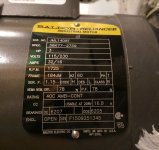Does this require user-configuration to select the voltage? Or is this the nature of a motor's winding in general, that it automatically draws a fixed steady state KVA that is independent of voltage, at any voltage within its rating range?
I would expect you'd have to change a tap on the motor windings, for it to work with a voltage that different.
The motors KVA shouldn’t change much whether the voltage is 240 and ampere 32 or 480 volts and 16 ampere. Mathematically, all you are doing is switching the positions of the products, voltage and current to be multiplied which yields the same KVA, perhaps you’re already aware.
Second a motor usually has 9 leads and for running a higher voltage you will wire the motor in series since more volts will have to be impressed across a larger span of wire turns
A lower voltage supply yields the motor being wired in parallel.
What I don’t get is that once I had single phase motors used as a rock pulverizers that ran better with the higher voltage option with less current but equal KVA as explained above compared to a lower voltage supply but higher current. I’m aware of the heat involved in the second option but the motors were designed to run either way and I didn’t expect such a difference in performance when the overall power was the same?

